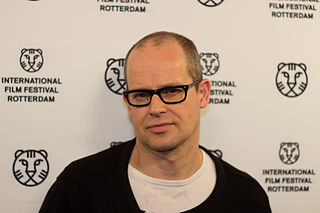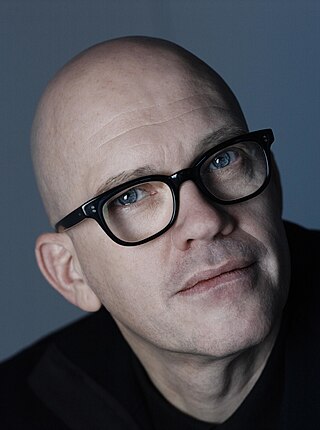James Lee Byars was an American conceptual artist and performance artist specializing in installations and sculptures, as well as a self-considered mystic. He was best known for his use of personal esoteric motifs, and his creative persona that has been described as 'half dandified trickster and half minimalist seer'.
Vija Celmins is a Latvian American visual artist best known for photo-realistic paintings and drawings of natural environments and phenomena such as the ocean, spider webs, star fields, and rocks. Her earlier work included pop sculptures and monochromatic representational paintings. Based in New York City, she has been the subject of over forty solo exhibitions since 1965, and major retrospectives at the Museum of Modern Art, Whitney Museum of American Art, Los Angeles County Museum of Art, San Francisco Museum of Modern Art, Institute of Contemporary Arts, London and the Centre Pompidou, Paris.

Andreas Gursky is a German photographer and professor at the Kunstakademie Düsseldorf, Germany.
Royden Rabinowitch, is a Canadian post-minimalist sculptor who exhibits internationally. Some critics consider him one of the pioneers of modern sculpture. Rabinowitch was elected Visiting Associate 1983/84; Visiting Fellow 1984/85 and Life Member 1986 of Clare Hall, Cambridge University. In 2002, he was appointed Officer of the Order of Canada (OC). He lives and works in Ghent, Cambridge, UK, and Waterloo, Ontario.

Sheila Hicks is an American artist. She is known for her innovative and experimental weavings and sculptural textile art that incorporate distinctive colors, natural materials, and personal narratives.

Gaetano Pesce is an Italian architect and a design pioneer of the 20th century. Pesce was born in La Spezia in 1939, and he grew up in Padua and Florence. During his 50-year career, Pesce has worked as an architect, urban planner, and industrial designer. His outlook is considered broad and humanistic, and his work is characterized by an inventive use of color and materials, asserting connections between the individual and society, through art, architecture, and design to reappraise mid-twentieth-century modern life.
Thomas Scheibitz is a German painter and sculptor. Together with Tino Sehgal he created the German pavilion on the 51st Venice Biennale in 2005. He lives and works in Berlin.
Lothar Hempel is a German artist based in Berlin. He attended Kunstakademie Düsseldorf from 1987 to 1992.

Ross Lovegrove is a Welsh artist and industrial designer.

The Grillo telephone was manufactured in Italy by Italtel for Società Italiana per l'Esercizio delle Telecomunicazioni, a former state-owned telecommunications company which is now part of Telecom Italia. "Grillo" was introduced in 1967 and remained in production until 1979.
Michelle Stuart is an American multidisciplinary artist known for her sculpture, painting and environmental art. She is based in New York City.
Janise Yntema is an American painter working in the ancient wax encaustic technique. Yntema was born in New Jersey and attended Parsons School of Design and the Art Students League of New York. She has had solo exhibitions in New York and throughout the United States as well as London, Amsterdam and Brussels. Her works are in the collections of several museums in Europe and the United States, including the Museum of Modern Art and Metropolitan Museum of Art.

Erik Gerardus Franciscus van Lieshout is a Dutch contemporary artist most widely known for his installations. In 2018, he won the Heineken Prize for Art.

Henk Stallinga is a Dutch multidisciplinary contemporary artist based in Amsterdam.
Edda Renouf is an American painter and printmaker. Renouf creates minimalist abstract paintings and drawings developed from her close attention to subtle properties of materials, such as the woven threads in linen canvas and the flax and cotton fibers of paper. Renouf often alters these supports by removing threads from the weave of a canvas, or in her drawings, creating lines by incising the paper.

La Boîte-en-valise is a type of mixed media assemblage by Marcel Duchamp consisting of a group of reproductions of the artist's works inside a box that was, in some cases, accompanied by a leather valise or suitcase. Duchamp made multiple versions of this type between 1935 and 1966. Titled From or by Marcel Duchamp or Rrose Sélavy (de ou par Marcel Duchamp ou Rrose Sélavy [Boîte-en-valise], Duchamp conceived of the boxes as a portable museum:
Instead of painting something new, my aim was to reproduce the paintings and objects I liked and collect them in as small a space as possible. I did not know how to go about it. I first thought of a book, but I did not like the idea. Then it occurred to me that it could be a box in which all my works would be collected and mounted like in a small museum, a portable museum, so to speak. This is it, this valise.
Rodney Ripps is an American artist, painter, and sculptor. Ripps is most known for textural density, heavy layering of materials, and heightened canvases in his work, often produced with high volumes of oil paint and incorporation of artificial leaves and metals, among other materials.
Jeremy Shaw is a Canadian visual artist based in Berlin, Germany.
Bertrand Lavier is a French conceptual artist, painter and sculptor, belonging to the post-readymade era, inspired by the Duchampian legacy and the Nouveau réalisme, the artistic movement created by the art critic Pierre Restany in 1960. Lavier studied at the École Nationale Supérieure d'Horticulture in Versailles, France in 1968-1971.

Jean Le Gac is a French conceptual artist, painter, pastelist, photographer using mixed media, frequently video or photography and text to document his investigations and sketched scenes. His poetic photographic interventions in which he is most often the main subject are accompanied either by typed text describing the underlying story in the artwork or handwritten notes in the art piece itself. Member of the Narrative art movement since the seventies, Le Gac ofttimes tells a story about an imaginary character that viewers can easily identify with the artist himself. He calls it a “metaphor for painting." Le Gac also uses the artist's book as a central part of his art practice. Le Gac is a Professor and lecturer at Institut des hautes études en arts plastiques.









